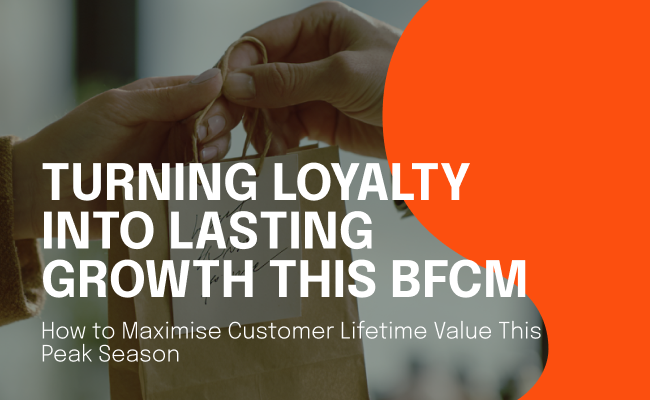Beyond the Sale: How to Maximise Customer Lifetime Value This Peak Season
Last week, we talked about why retention beats reach during BFCM and how loyalty, not traffic, turns a strong weekend into a strong year.
If loyalty is the first win, the next step is turning it into lasting growth. That’s where Customer Lifetime Value comes in. CLV shows the real health of a business, how well it keeps customers coming back and how much value they create over time.
This piece builds on Build Loyalty This BFCM: Why Retention Beats Reach Every Time as part of our Power Up for the Peak series. It looks at how to make every loyal customer worth more through smarter systems, stronger experiences, and the kind of consistency that compounds long after peak season ends.
Why Lifetime Value Matters More Than Revenue Spikes
Black Friday and Cyber Monday bring impressive numbers. Sales rise fast, dashboards look healthy, and everything moves at full speed. But when the rush is over, the question is simple. How many of those customers will return?
This is where Customer Lifetime Value matters. CLV measures how much revenue each customer brings over time. It helps you see if the sales you worked so hard for are building something repeatable or just a one-off win.
By tracking CLV, brands start making decisions differently. They plan stock and marketing around repeat buyers, not just traffic. They use data to spot which customers are worth keeping and which campaigns are actually profitable.
As shared in Turning Borrowed Capital into Lasting Growth, sustainable growth comes from knowing where your effort pays back over time. CLV gives that clarity. It shows the real return on every sale, not just the short-term spike.
The businesses that understand this do not see BFCM as a finish line. They treat it as the start of the next relationship.
How to Grow CLV Without Growing Spend
Customer Lifetime Value grows when you give people reasons to return, not when you spend more to find them. The best brands do this through consistency. Every order, email, or interaction adds a layer of trust that keeps customers coming back.
To make that effort measurable, you first need to understand how to calculate CLV. The simplest way to do this is:
CLV = Average Order Value × Purchase Frequency × Customer Lifespan
It tells you how much an average customer is worth over time. For example, if a customer spends £50 per order, buys four times a year, and stays loyal for three years, their CLV is £600. This single number can reshape your decisions.
Once you know your CLV, compare it to your Customer Acquisition Cost (CAC). If it costs £150 to acquire that customer, your profit potential becomes clear. This ratio (CLV to CAC) shows whether you are building sustainable growth or burning through cash.
To increase CLV, focus on improving one of three areas:
- Average Order Value – Offer bundles or personalised add-ons that make sense for the customer, not just for the sale.
- Purchase Frequency – Use smart reminders, email flows, or replenishment subscriptions to bring customers back sooner.
- Customer Lifespan – Keep engagement alive after the purchase. Share updates, rewards, and early access to new products.
As we explored in Why Growth Hacks Fail, lasting growth does not come from short-term tricks. It comes from habits that quietly build over time.
By tracking CLV, you can see where every improvement counts. You do not need more ads or bigger budgets. You just need better systems that make loyalty worth more.
Funding Long-Term Growth Without Short-Term Strain
Building loyalty and growing lifetime value take time, creativity, and cash flow. It is not about throwing more money at ads but about giving your business the breathing room to invest in what works.
Smart founders use funding to support the systems that strengthen retention. That could mean improving the customer experience, upgrading packaging, automating post-purchase journeys, or launching a loyalty programme. Each of these helps customers come back — but all of them require working capital to set up properly.
This is where flexible funding matters. With Juice’s Smart Growth Capital, brands can reinvest in their strongest relationships without putting pressure on daily operations. It allows you to order stock ahead of demand, scale marketing that is already converting, or experiment with small upgrades that make a big impact on experience.
As we shared in one of our latest articles, good debt is not a risk when it drives long-term value. The goal is not to borrow for the sake of growth but to borrow for the sake of longevity.
The most resilient brands plan for tomorrow while serving today. They treat funding as a tool to keep momentum, not a shortcut to scale. That mindset turns loyalty into an asset that compounds — one repeat customer at a time.
Build Once, Earn Twice
Customer Lifetime Value is the quiet measure of real growth. It shows whether your customers are coming back, spending more, and staying longer.
Loyalty and lifetime value go hand in hand. One builds the habit, the other builds the return. The strongest brands do not rely on one weekend of sales. They create systems that reward consistency, care, and connection all year round.
Here is where to focus next:
- Keep measuring CLV to understand what drives lasting returns.
- Invest in the experience, not just the offer.
- Use flexible funding to improve retention systems that already work.
- Turn your customer base into a community that grows with you.
As we covered throughout the Power Up for the Peak series, growth is not about doing more. It is about doing what matters, with intention, with insight, and with support that lasts.
And if you know a business that could benefit from the same kind of growth capital, share it through our Referral Programme. Growth is better when it is shared.



